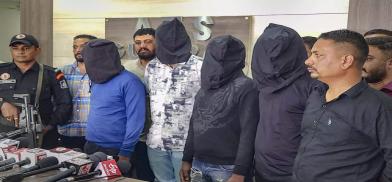Intelligence sharing between India, Sri Lanka imperative to curb mounting IS threat to South Asia
The arrest of four Sri Lanka nationals last month in Ahmedabad, India by Gujarat's Anti-Terrorism Squad caught the attention of Sri Lankan authorities. During interrogation, the four admitted to being closely involved with the banned NTJ and confessed they joined IS through Pakistani handler Abu Bakr Al Baghdadi.

The Government of Sri Lanka did not make committed attempts to de-radicalise the Muslim youth in the aftermath of the Easter Sunday massacre. On the contrary, the government came into power after ousted President Gotabaya Rajapaksa in 2022 opted for a doctrine of appeasement by making a few detrimental blunders. The conspiracy narrative propagated in social media and many other platforms without substantive evidence undermined the process of taking action against Muslim radicalism as many of the Muslim politicians heralded this false narrative. Some Muslim politicians dismissed the issue of Islamic radicalism in the Parliamentary Committee on National Security last August stating the whole Easter attack was a covert operation carried out by a foreign intelligence service. Minister Rauf Hakeem noted that Israeli intelligence Mossad stood behind the 2019 attacks.
Upon the recommendation of Justice Janak de Silva’s Presidential Commission of Inquiry into the Easter Sunday attack, the Sri Lankan government proscribed organisations that promoted extremist ideas and ideologies. They included the National Tawheed Jamaat (NTJ), Jamiatul Ansari Sunnatul Mohammadia (JASM), Sri Lanka Tawheed Jamaat (SLTJ), All Ceylon Tawheed Jamaat (ACTJ), Lanka Tawheed Jamaat (CTJ), and the United Tawheed Jamaat (UTJ) in April 2021. After Muslim leaders and politicians lobbied the government, it was decided to conditionally lift the ban imposed on five of the 11 Islamist organizations in July 2023. The five organizations were JASM, SLTJ, ACTJ, CTJ and UTJ.
These organizations were ideological hubs of Wahhabism. In his seminal work Prof. Rohan Gunaratna traces the ideological evolution of Islamic radicalism in Sri Lanka through the financial assistance from the Gulf States from the 80s. The movement that emerged in Sri Lanka consolidated the radical ideas of Tawhid and many of the Tawhid organisations became breeding grounds for jihadism. In this situation, lifting the ban on the five organisations was a blow to national security.
ISKP's growing presence
The increasing activities of Islamic State for Khorosan province ( ISKP) across South Asia is seen to pose a threat to regional security. The arrest of four Sri Lanka nationals last month in Ahmedabad, India by Gujarat's Anti-Terrorism Squad caught the attention of Sri Lankan authorities. During interrogation, the four admitted to being closely involved with the banned NTJ and confessed they joined IS through Pakistani handler Abu Bakr Al Baghdadi.
The question that arises is what motivates the ISKP to radicalise Sri Lankan Muslims to carry out attacks in the region? The polarization that occurred within Sri Lankan society after the end of the country’s civil war marginalized the Muslim community. Additionally, militant Buddhist movements such as BBS worsened the divide by spreading anti-Muslim rhetoric. The communal riots in 2014 and 2018 escalated to a dangerous level with the Easter attacks in 2019 in Sri Lanka resulting in nearly 400 deaths. The widespread conspiracy theories surrounding the Easter attack aimed to deny the reality of radicalism.
Neither the Muslim community nor its political leaders admitted that certain Muslim individuals had already formed links with Indian jihadi cells, mainly in the southern state of Kerala with its significant Muslim population. The state's close contacts with the Gulf countries since the 1970s followed by the influx of Saudi money, which led to the establishment of Salafi cells, expedited the radicalization. After the Easter attack in 2019, it was not by a coincidence that Indian intelligence tried to trace some possible links between Sri Lankan attackers and radicalised youth in Kerala.
Regional intel sharing
Since the territorial loss of IS in 2019 and the death of its leader Abu Bakr al-Baghdadi, the threat from IS terrorism has begun to wane. But its ideological influence was not debilitated as its decay bolstered the rise of regional splinter groups at an unprecedented level. The emergence of ISKP, comprising militants of many ethnicities ranging from Tajiks to Afghans to South Asian Muslim youth, poses a growing challenge for regional security agencies. To avert a security breakdown in South Asia, regional security networks should forge intelligence sharing among themselves resembling the five eyes model (US, Canada, UK, Australia and New Zealand). The Sri Lankan case is a fine example of how ISKP activism can infiltrate into a country where the Muslim community remains below 10 per cent. In particular, the growing rift between the majority of Sinhalese Buddhists and the Muslim community creates a space for external actors to exploit.
On the other hand, it is a fact that Sri Lankan intelligence was alerted to most of the IS activities in the island in the recent past by Indian intelligence, which indicates continuous intelligence sharing between the two countries. As security analyst Kabir Tenja stated in India Today, the regional security architecture is required to be strengthened under India’s orbit before the next large-scale attack occurs.
(The author is a post-doctoral researcher affiliated with the Institute of Law, Politics and Development at Scuola Superiore Sant Anna, Pisa, Italy. Views are personal. He can be reached at punsaraprint10@gmail.com )









Post a Comment